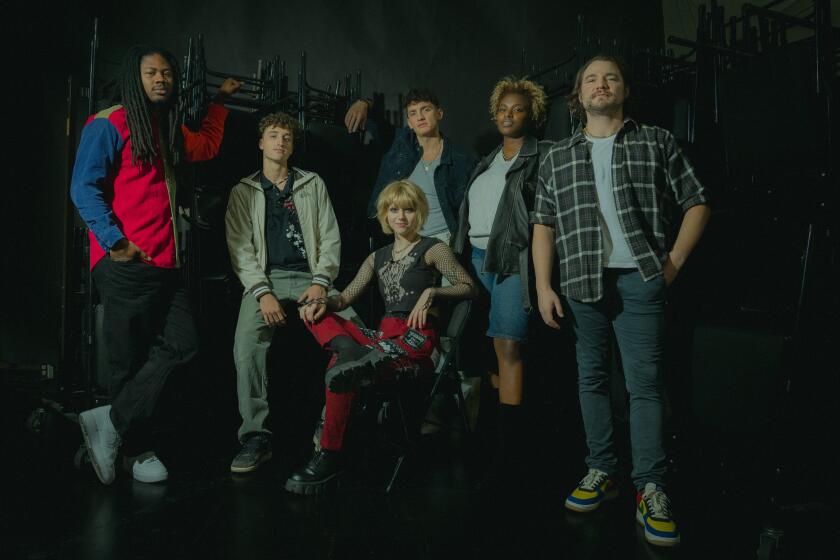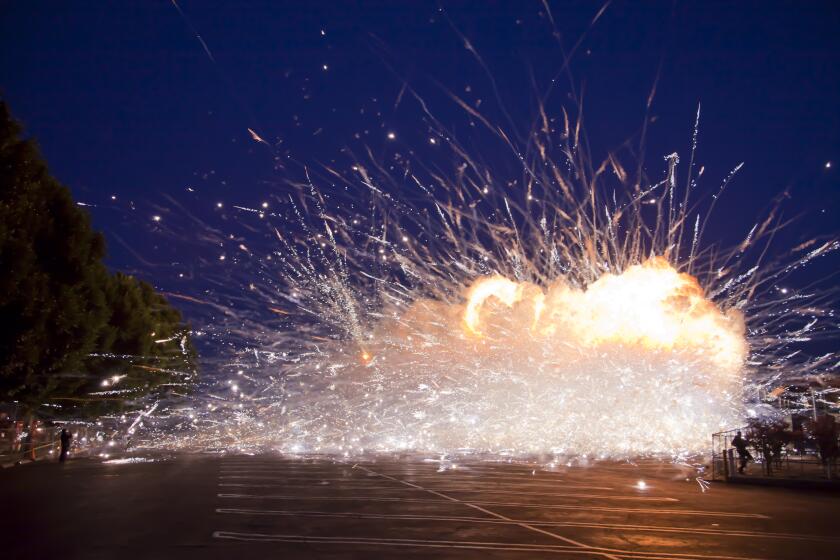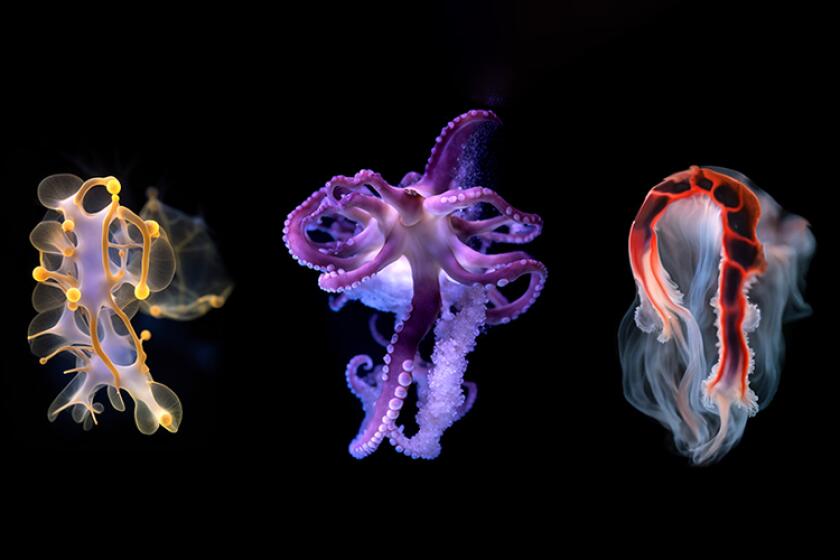The Linear Route to Peru’s Past
Strombus Monster Meets Demon Fish! Wrinkle Face Battles Crab Deity! Fox-Head Fish Fights Sea Anemone!
The curved clay surfaces of Moche vessels from ancient Peru are sites of extraordinary imaginative activity, rendered in linear drawings that range from blunt to delicate, emblematic to impossibly intricate. Some of the imagery is supernatural, some is not, but all of it speaks of a worldview so complex and alien to modern life as to be nearly impenetrable.
“Moche Fineline Painting of Ancient Peru” is a small but fascinating exhibition at UCLA’s Fowler Museum of Cultural History. It goes a long way toward unraveling some of the secrets of these often exquisite pots, without shattering their evocative mystery. Only 33 vessels are on view, but the richness and sophistication evident in so many of them make for a fully satisfying show.
The Moche (pronounced moe-chay) civilization flourished along 300 miles of coastal Peru between 100 and 800, long before the rise of the Incas. It occupied the numerous river valleys stretching from the Andes Mountains to the Pacific Ocean that line up one after the other, almost in parallel rows. Farmers, hunters and fisherman, the Moche developed a wealthy, stable, stratified society whose artisans appear to have produced exceptional objects for elite patrons. (Like unsigned Greek vases, multiple vessels even reveal the hand of individual artists.) As with many ancient civilizations, burial chambers have provided a trove of objects with which researchers have been able to reconstruct significant elements of this lost society of pre-Columbian Peru.
At the Fowler, a central gallery lays out the basics of Moche fineline painting, which--as the painting term implies--consists of a flat, linear, always two-dimensional drawing style that gets increasingly intricate as time goes by. The exhibition is heavily didactic, with numerous explanatory text panels and a lot to read. Indeed, the abundance of words is rather ironic, given a civilization that developed no written language of its own. But the texts that are offered are clear and informative--and probably necessary in light of the subject’s remoteness.
*
Anthropologists have traditionally divided Moche fineline painting into five historical phases, largely based on the shapes of the vessels’ spouts--their length, style of lip, etc. The spouts themselves are distinctive; a cylinder tops a hollow arch, which looks rather like a handle for carrying the bottle. This shape gave rise to the descriptive term, stirrup-spouts. Yet the shape also appears sexualized, an emblematic union of male and female forms attached to the vessel’s body.
The pots are of modest size (less than 1 foot tall). Some take the form of an animal--deer, owl, condor--or of human figures, like a mother with a small child in her lap or a distinctive portrait head. A singular pot (and one of the most beautiful) is shaped like a bumpy squash. Those that are painted with narrative scenes are typically simple ovoids, with the stirrup-spout at the top. Browns, tans, reds, blacks, whites and other earth tones predominate, both in the clay body and the clay slip with which the bottles are painted.
The imagery in fineline painting starts out supernatural, but by phase four it’s almost entirely natural--hunters, warriors, ceremonies, reed boats, games, dances, erotic activities, etc. Then, in phase five, it goes supernatural again.
The pictures also start out simple and self-contained. Eventually figures begin to interact. By phase five, every available inch of the surface is covered with intricate rendering, as horror vacuii--a shuddering fear of empty space--seems to take over. What began in phases one and two as an independent emblem ends up a dazzling, ecstatic cosmology, a shifting universe that sometimes recalls the exquisite “Constellation” watercolors of Miro.
Most Moche fineline paintings that survive are from phase four, and these represent the largest number of vessels (13) in the show. Second is phase five (eight pots), where the fantastic, shape-shifting creatures and dense compositions seem almost Mannerist in their irrationality. So complex are these painted surfaces that it’s nearly impossible to tell what’s going on. And that’s where the impetus for this exhibition came in.
Organized by Donald and Donna McClelland, the show is based on 30 years of research by UCLA anthropologist Christopher B. Donnan and Donna McClelland. The two scholars developed a makeshift yet highly productive method for untangling the knot of fineline drawings on Moche pots. Like cartographers making flat maps that describe spherical worlds, they figured out a way to make what they call “roll-out drawings,” which transfer the tangled imagery on the curved surface of a small pot onto a large sheet of paper. (A section of the show explains how they do it.) Four dozen copies of these roll-out drawings are included in the show, often accompanied by the actual vessel from which each was taken. Suddenly, the exotic imagery begins to make wondrous sense.
Among the more remarkable examples is a burial ceremony, which shows the conditions in which the vessels themselves were used. You could stare at this intricate vessel for hours, making out fearsome faces amid whirling abstract patterns in reddish slip on a creamy tan background, but without ever being able to really read the image. The roll-out drawing snaps things into place: Figures are lowering a shrouded corpse down a burial shaft, warriors are lined up for the ceremony, a mysterious exchange of conch shells takes place atop an altar-like platform and more.
*
Many things, of course, remain obscure, like who’s giving the conch shell to whom, and why? But being able to read the general picture paradoxically makes the distance between Moche civilization and us more palpable and immediate than before. You know that they needed no explanatory chart, that the anonymous but gifted artist who painted this scene was rendering a fully coherent visual world of great depth and intensity. The gaping sense of estrangement makes the imaginative program of Moche fineline painting all that much more remarkable.
*
* “Moche Fineline Painting,” UCLA/Fowler Museum of Cultural History, (310) 825-4361, through Feb. 18. Closed Mondays and Tuesdays.
More to Read
The biggest entertainment stories
Get our big stories about Hollywood, film, television, music, arts, culture and more right in your inbox as soon as they publish.
You may occasionally receive promotional content from the Los Angeles Times.







